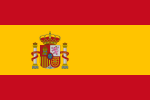
Back Spaanse Vloot Afrikaans البحرية الإسبانية Arabic Armada Española AST Armada Espanyola Catalan Španělské námořnictvo Czech Armada Española Danish Armada Española German Ισπανικό Πολεμικό Ναυτικό Greek Hispania mararmeo Esperanto Armada española Spanish
This article includes a list of general references, but it lacks sufficient corresponding inline citations. (August 2022) |
| Spanish Navy | |
|---|---|
| Armada Española | |
 | |
| Founded | 15th century |
| Country | |
| Type | Navy |
| Size | 20,838 personnel (2016)[2] 139 ships[3] 54 aircraft[4] |
| Part of | |
| Garrison/HQ | Headquarters:
Main naval bases:
|
| Patron | Our Lady of Mount Carmel (Spanish: Nuestra Señora del Carmen) |
| March | Himno de la Escuela Naval (José María Pemán) |
| Anniversaries | 16 July |
| Website | www |
| Commanders | |
| Commander in Chief | |
| Admiral Chief of the Naval Staff | |
| Insignia | |
| Jack |  |
| Ensign |  |
| Aircraft flown | |
| Attack | McDonnell Douglas EAV-8B Harrier II+ |
| Fighter | McDonnell Douglas EAV-8B Harrier II+ |
| Helicopter | Sikorsky SH-60B Seahawk |
| Cargo helicopter | Sikorsky SH-60F Seahawk |
| Multirole helicopter | Agusta Bell AB-212+ |
| Trainer helicopter | Airbus H135 |
| Reconnaissance | Boeing Institu ScanEagle |
| Trainer | McDonnell Douglas TAV-8B Harrier II |
| Transport | Cessna Citation |
The Spanish Navy, officially the Armada, is the maritime branch of the Spanish Armed Forces and one of the oldest active naval forces in the world. The Spanish Navy was responsible for a number of major historic achievements in navigation, the most famous being the discovery of America and the first global circumnavigation. For several centuries, it played a crucial logistical role in the expansion and consolidation of the Spanish Empire, and defended a vast trade network across the Atlantic Ocean between the Americas and Europe, and the Manila Galleon across the Pacific Ocean between the Philippines and the Americas.
The Spanish Navy was one of the most powerful maritime forces in the world from the late 15th century to mid-17th century.[5] In the early 19th century, with the loss of most of its empire, Spain transitioned to a smaller fleet but maintained a major shipbuilding industry which produced important technical innovations. The Spanish Navy built and operated the first military submarines,[citation needed] made important contributions in the development of destroyer warships, and again achieved a first global circumnavigation, this time by an ironclad vessel.
The main bases of the Spanish Navy are at Rota, Ferrol, San Fernando and Cartagena.
- ^ Española, Armada. "Armada Española – Ministerio de Defensa – Gobierno de España". www.armada.mde.es. Archived from the original on 7 July 2015. Retrieved 11 July 2015.
- ^ "España Hoy 2016-2016". lamoncloa.gob.es (in Spanish). Archived from the original on 10 May 2017. Retrieved 27 May 2017.
- ^ "LISTA OFICIAL DE BUQUES DE LA ARMADA". Spanish Navy. Archived from the original (PDF) on 1 January 2023. Retrieved 9 March 2024.
- ^ "AERONAVES MILITARES ESPAÑOLAS". aeronavesmilitaresespanolas.com. Archived from the original on 14 December 2023. Retrieved 9 March 2024.
- ^ Márquez, Carlos E. (2016). "Plus Ultra and the Empire Upon Which the Sun Never Set". In Tarver, H. Micheal; Slape, Emily (eds.). The Spanish Empire: A Historical Encyclopedia [2 volumes]: A Historical Encyclopedia. ABC-CLIO. ISBN 978-1610694223. Archived from the original on 14 January 2023. Retrieved 19 September 2022.